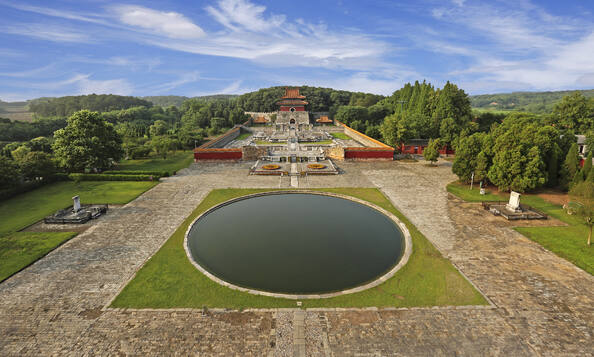Tumbas imperiales de las dinastías Ming y Qing
Imperial Tombs of the Ming and Qing Dynasties
It represents the addition of three Imperial Tombs of the Qing Dynasty in Liaoning to the Ming tombs inscribed in 2000 and 2003. The Three Imperial Tombs of the Qing Dynasty in Liaoning Province include the Yongling Tomb, the Fuling Tomb, and the Zhaoling Tomb, all built in the 17th century. Constructed for the founding emperors of the Qing Dynasty and their ancestors, the tombs follow the precepts of traditional Chinese geomancy and fengshui theory. They feature rich decoration of stone statues and carvings and tiles with dragon motifs, illustrating the development of the funerary architecture of the Qing Dynasty. The three tomb complexes, and their numerous edifices, combine traditions inherited from previous dynasties and new features of Manchu civilization.
La description est disponible sous licence CC-BY-SA IGO 3.0
Tombes impériales des dynasties Ming et Qing
L’extension ajoute trois tombes impériales de la dynastie Qing à Liaoning aux tombes Ming inscrites en 2000 et 2003. Les trois tombes impériales de la dynastie Qing dans la province de Liaoning comprennent la tombe Yongling, la tombe Fuling et la tombe Zhaoling, toutes construites au XVIIe siècle. Erigées pour les empereurs fondateurs de la dynastie Qing et leurs ancêtres, ces tombes obéissent aux préceptes de la géomancie chinoise traditionnelle et de la théorie du fengshui. Elles offrent une riche décoration de statues en pierre, de bas-reliefs et de dalles ornées de dragons, illustrant l’évolution de l’architecture funéraire sous la dynastie Qing. Les trois complexes funéraires et leurs nombreux édifices conjuguent les traditions héritées des dynasties précédentes et les innovations de la civilisation mandchoue.
La description est disponible sous licence CC-BY-SA IGO 3.0
المقابر الامبراطورية لسلالتي مينغ وكينغ
تتوزّع مقابر سلاتي مينغ وكينغ على أربعة مجمّعات من المقابر في مقاطعات خمس من الصين الشرقيّة (هوباي، هاباي، حي شانغبينغ في بيجينغ، جيانغسو ولياونينغ). بُنيت هذه المقابر بحسب تعاليم ضرب الرمل الصيني، وهي برهان استثنائي على المعتقدات والتقاليد الصينيّة منذ القرن الرابع عشر كما أنّها أمثلة نفيسة عن الهندسة والفنون المطبّقة في تلك الحقبة.
source: UNESCO/CPE
La description est disponible sous licence CC-BY-SA IGO 3.0
明清皇家陵寝
位于辽宁省的清朝盛京三陵建于17世纪,是继2000年和2003年列入《世界遗产名录》的明朝寝陵之后的三座清朝皇家寝陵,分别为永陵、福陵和昭陵,是开创满清皇室基业的皇帝及其祖先的陵墓。寝陵遵照中国传统的占卜和风水理论而建,饰以大量以龙为主题的石雕、雕刻和瓦片,展示了清朝墓葬建筑的发展。盛京三陵及其众多建筑将以前朝代的传统和满族文化的新特征融为一体。
source: UNESCO/CPE
La description est disponible sous licence CC-BY-SA IGO 3.0
Гробницы императоров династий Мин и Цин
Императорские гробницы династий Мин и Цин – это несколько групп погребальных сооружений в разных провинциях Восточного Китая. Гробницы, созданные в соответствии с принципами «фэн-шуй», являются выдающимся свидетельством китайских верований и традиций начиная с XIV в., а также служат ярким примером архитектуры и прикладного искусства того периода. В 2004 г. в объект дополнительно вошли три захоронения династии Цин XVII в. в провинции Ляонин – Юнлин, Фулин и Чжаолин, датируемые ХVII в. Сооруженные для императоров-основателей династии Цин и их преемников, они были богато украшены каменными скульптурами и рельефами, а также изразцами с изображениями драконов, что демонстрировало развитие погребальной архитектуры династии Цин. В архитектуре многочисленных зданий этих трех комплексов объединяются традиции, унаследованные от прошлых династий, и новые черты, свойственные маньчжурской культуре.
source: UNESCO/CPE
La description est disponible sous licence CC-BY-SA IGO 3.0
Tumbas imperiales de las dinastías Ming y Qing
Este sitio se ha ampliado con la adición de tres tumbas de la dinastía Qing a las sepulturas de los Ming, ya inscritas en la Lista del Patrimonio Mundial en 2000 y 2003. Las tres tumbas imperiales de Yongling, Fuling y Zhaoling, ubicadas en la provincia de Liaoning, fueron construidas en el siglo XVII para albergar los despojos mortales de los miembros fundadores de la dinastía Qing y sus antepasados. Su construcción se rigió por los preceptos de la geomancia tradicional china y la teoría del diseño de los espacios vitales (fengshui). Están magníficamente ornadas con estatuas de piedra, bajorrelieves y cerámicas con motivos de dragones, que ilustran el auge de la arquitectura funeraria en la época de los Qing. En las tres tumbas, que forman verdaderos complejos arquitectónicos con sus múltiples construcciones, se mezclan los elementos tradicionales de las anteriores dinastías reinantes en China con los nuevos aportes de la civilización manchú.
source: UNESCO/CPE
La description est disponible sous licence CC-BY-SA IGO 3.0
明・清朝の皇帝陵墓群
明と清時代の皇帝の墓は人類が介在して造られた自然遺産で、それは風水によって慎重に選ばれた。伝統的な建築デザインや装飾の建物が数多く存在している。それらは封建中国の世界観や権力の概念が5世紀にわたって続いたことを示している。source: NFUAJ
Keizerlijke graven uit de Ming en de Qing dynastie
De Ming en Qing keizerlijke graven getuigen van een culturele en architectonische traditie die meer dan 500 jaar dit deel van de wereld domineerde. Eerst werden de Xianling graven van de Ming dynastie aan de Werelderfgoedlijst toegevoegd. De graven stammen uit de vroeg-16e eeuw en zijn gelegen nabij de stad Zhongxiang, in de provincie Hubei, meer dan 1.000 km van Beijing. Het bijzondere is de volstrekte integratie van de graftombes in de natuurlijke omgeving. In 2004 werden ook de Qing graven bijgeschreven. Deze drie keizerlijke graven in de provincie Liaoning zijn het Yongling graf, het Fuling graf en het Zhaoling graf. Ze werden alle drie gebouwd in de 17e eeuw. De graven zijn volgens traditionele Chinese geomantiek en fengshui richtlijnen opgebouwd. Ze zijn rijkelijk versierd met stenen beelden, graveringen en tegels met drakenmotieven, waarmee ze de grafarchitectuur van de Qing dynastie illustreren. De drie grafcomplexen en hun talrijke bijgebouwen combineren tradities van vorige dynastieën en nieuwe elementen van de Manchu beschaving.
Source : unesco.nl
